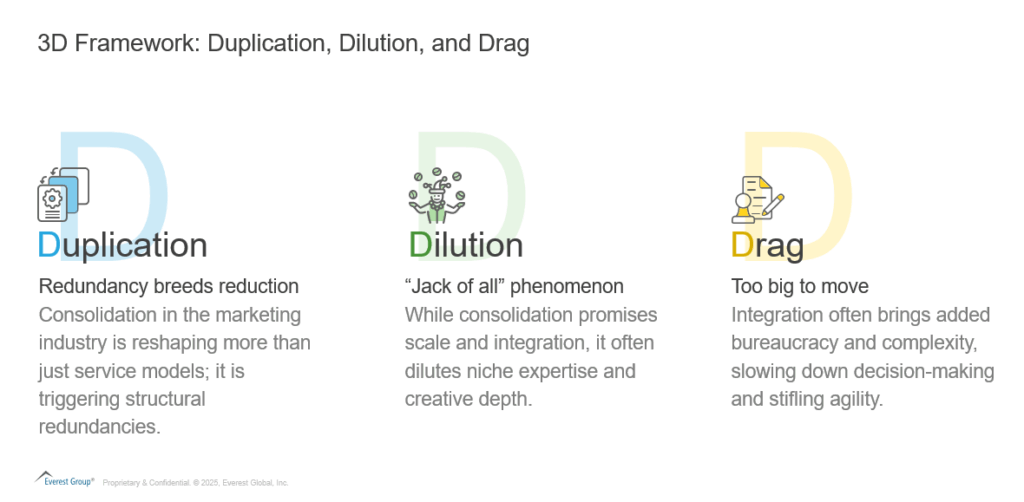
Unprecedented consolidation has occurred in the marketing and advertising industry in recent years. To establish one-stop-shop models that provide fully integrated end-to-end marketing services, major holding companies and consultancies have acquired specialized firms and merged agencies. The rationale is simple: having data, digital, media, and creative all in one place ensures smooth, consistent campaigns across all channels.
Consolidating multiple agencies into an integrated offering can result in operational scale and service breadth. However, greater scale doesn’t always translate to better outcomes without strategic coherence and executional depth, so the question stands whether bigger truly means better for marketers.
Reach out to discuss this topic in depth.
Notable examples of integration of marketing agencies include:
- WPP Media
In 2025, WPP rebranded its media division as “WPP Media,” retiring the GroupM brand and consolidating its data, media, and content production capabilities under a single AI-powered entity. The three main agency brands, Mindshare, Wavemaker, and EssenceMediacom, remain sub-brands of WPP Media’s cohesive ecosystem.
- Publicis Groupe Combines Leo Burnett & Publicis Worldwide into “Leo”
In January 2025, Publicis Groupe merged its renowned Leo Burnett network with Publicis Worldwide to create a single worldwide creative unit known as “Leo” marking a significant convergence of its creative firms.
Strategically, this combination combines Publicis’s operations and unifies its creative capabilities to better serve global companies. Publicis can provide clients with the “largest creative network” with more resources and integrated creative talent globally by removing internal silos between the two networks. The move is consistent with Publicis’s “Power of One” philosophy.
- Omnicom and IPG merger
In December 2024, Omnicom Group announced that it has acquired Interpublic Group (IPG) for $13 billion. The merger seeks to consolidate resources and enhance technological capabilities.
Read more on this topic here.
Structural and strategic challenges of agency consolidation

Duplication: Redundancy breeds reductions
Teams, systems, and roles within a merged organization frequently overlap as a result of consolidation. This structural duplication causes inefficiencies and encourages cost-cutting strategies, which often result in layoffs.
Significant organizational and structural changes brought about by the rebranding as WPP Media have also resulted in widespread layoffs throughout North America and Europe, impacting employees at all levels.
Notably, employment at U.S. ad agencies has been consistently dropping.
This shows how consolidation is affecting not only service models, but also the talent pool that drives innovation and differentiation.
Dilution: “Jack of all” phenomenon
Specialized knowledge can be diluted by mergers and integrated “one-stop-shop” models. As the new organization concentrates on broad offerings, niche competencies and creative excellence that were the hallmark features of smaller units may get diluted.
Convenience may be gained by buyers who combine their agency rosters, but this may lead to a trade-off in capability depth. Relying on a single large provider can mean less access to cutting-edge specialty talent.
Although agency consolidation is marketed as a means of achieving integration and scale, prevalent market commentary and employee sentiment indicate that it may do more harm to clients than good.
Drag: Too big to move
Along with growth, integration also adds bureaucracy, complexity, and delays in decision-making, which lead to organizational drags. A consolidated marketing organization has additional levels to manage, which may cause delays and barriers to flexibility.
As a result, teams may find it difficult to experiment with new formats, make quick campaign pivots, or react swiftly to changes in the market, which undermines the very responsiveness that modern marketing demands.
The Road to the future: Reimagining the post-consolidation marketing landscape
- From Integration to Orchestration
Agency mergers are just the beginning; the true value lies in orchestrating capabilities by harmonizing strategy, analytics, content, and creative around client outcomes. Instead of relying on inflexible mega-structures, success will rely on developing modular, interoperable teams.
- Talent strategy as a differentiator
Agencies need to move away from “headcount rationalization” and toward creating resilient, forward-thinking teams that combine rapid technical advancements with human innovation. This calls for a conscious move toward the development of new skills, modern hiring practices, and an experimentally rewarded culture.
- Reinvesting in Specialization
Restoring centers of excellence within integrated networks and retaining in-depth knowledge of performance media, brand strategy, Customer Experience (CX), and analytics will be necessary for leading businesses to combat dilution. Instead of having to choose between specialization and scaling, the future agency must balance both.
To share your perspectives and to hear more about the ever-changing landscape of marketing, please reach out to Akshara Vaidhyanathan ([email protected]) and Nisha Krishan ([email protected]).











